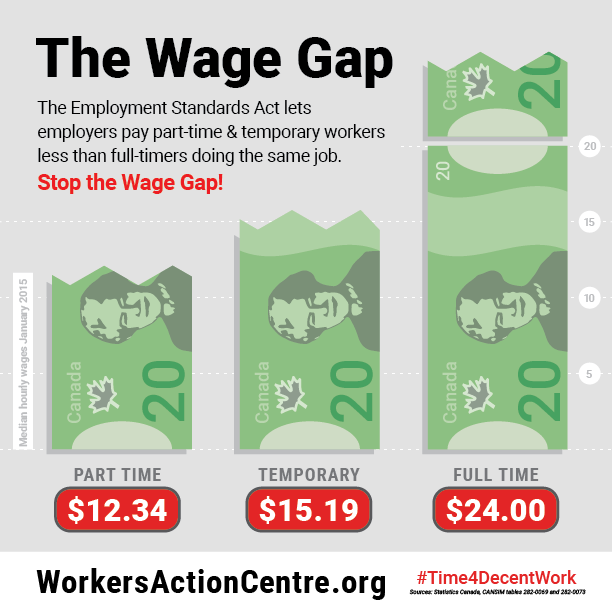Homelessness is closely connected to issues of poverty, inadequate income and unemployment. This week's infographic takes a look at the wage gap that exists between part-time and temporary workers compared to full-time workers doing the same job in Ontario. The content in this infographic is drawn from Still Working On The Edge, a policy paper published by the Workers' Action Centre that identifies problems today's workers are facing in the labour market. The specific numbers are drawn from recently published Statistics Canada figures that look at median hourly wages for part-time, temporary and full-time workers.
Median wages earned by part-time, temporary and full-time workers in Ontario vary greatly. The infographic states that while full-time workers earn a salary for $24.00/hr, temporary workers earn just $15.19/hr. Part-time workers earn even less, just $12.34/hr, almost half of what full time workers earn for doing the same job. Workers Action Centre partially attributes these discrepancies to gaps present in the Employment Standards Act.
What is the Employment Standards Act?
In Ontario, the Employment Standards Act (ESA) provides the minimum standards for working in the province. The Act outlines the rights and responsibilities of both employers and employees. Different provinces have similar acts to the ESA. For example, Manitoba has an Employment Standards Code and Newfoundland has a Labour Standards Act, both of which carry out similar functions to the ESA. These kinds of acts play a critical role in determining the minimum conditions for work. This includes rules and regulations for overtime, wages, annual vacations and even termination of employment.
Gaps present in the ESA allow temporary and part-time workers to be paid less than their full-time counterparts. This ultimately acts as a cost-saving incentive for companies and organizations to "move work beyond the reach of ESA protection". Lack of protection for workers by the ESA leads to the exploitation of temporary and part-time workers in Ontario.
What can be done?
The great thing about legislation like the ESA is that it is not set in stone. Amendments can be made to reflect changing employment trends. This past February, the Ontario government launched the Changing Workplace Review. Growing employment precarity, marked by non-standard working relationships like temporary jobs and part-time work, is an example of a workplace trend that will be examined in the consultation. The review provides the government, and its citizens, with the opportunity to address how employment is changing in Ontario.
While today's infographic focuses on the province Ontario, this discussion is of relevance to employers and employees across Canada. Today, because of changing labour market trends, a job on its own does not guarantee freedom from poverty. In 2011, 44% of poor households in Canada had at least one person working, and this percentage has likely increased since then. In order to prevent the continued exploitation of workers, the employment standards and regulations that we have in place need to be carefully examined to reflect the monumental changes have taken place in the Canadian marketplace.


